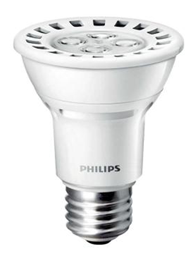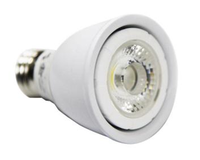This following article is a blog entry written by Noah Horowitz, senior scientist in NRDC's energy program.
The California Energy Commission (CEC) made history again today when it set minimum energy efficiency standards for small diameter directional light bulbs used for accent, spot and track lighting that will be the most stringent in the world. The reflector bulbs, which are less than 2.25 inches in diameter, are most commonly found in retail stores, museums, and hotels, and increasingly in new and remodeled homes.
The standards will require bulbs manufactured or brought into California after Jan. 1, 2018, to use up to 85 percent less energy than the current inefficient incandescent and halogen models, and for the bulbs to last a minimum of 25,000 hours. There are currently no national energy efficiency standards for these types of bulbs.
While the new California standards are technology neutral and allow for any type of bulb to be sold as long as they meet the requirements, the new bulbs meeting the requirements are likely to all be LEDs.
 |
|
A Philips LED bulb. (All photos courtesy of NDRC) |
The savings really add up
There are approximately 16 million small diameter directional lamps currently installed in California. The CEC estimates that once these are replaced with new bulbs that meet the California standards, the state's homes and businesses will save 2,285 gigawatt-hours of electricity per year. To put that in perspective, the standards will:
Reduce Californians' electric bills by more than US $400 million annually;
Prevent more than 10 million cumulative tons of carbon dioxide emissions from 2018 through 2029 from power plants, one of the major sources of climate change pollution;
 |
|
A LED bulb. |
Save twice as much electricity every year as is consumed annually by all the households in Oakland, California's eighth-largest city and home to the world champion Golden State Warriors basketball team.
A big win for businesses and consumers
The old directional bulb that used 50 watts of electricity and lasted around 2,500 to 5,000 hours will be replaced by a compliant LED bulb that uses less than 10 watts and last at least 25,000 hours. The new efficient LED bulbs are just as bright and do everything the old ones did - they are dimmable and can be made to deliver a narrow or wide beam of light. Plus, the longer lifetime means no more annual trips up the ladder to change out the burned-out bulb.
While a more efficient LED bulb will cost a little more than the incandescent and halogen versions, the user can save over $200 over the life of the bulb and recover their upfront investment in less than a year.
Despite the compelling economics over the lifetime of the commonly available LED bulbs and their environmental benefits due to lower energy use, many consumers continue to buy the halogen and incandescent bulbs because of their lower prices. The CEC unanimously adopted today's standard to ensure a minimum level of energy savings for the millions of small directional bulbs being used in California because cutting energy waste reduces the need to burn fossil fuels while generating electricity - and avoids their associated emissions.
As goes California....
As is commonly the case, let's hope these California standards serve as a model and catalyst for future adoption by other leading states and eventually at the national level by the U.S. Department of Energy. If they go national, the benefits will grow dramatically and would save our country more than $2.5 billion a year on our energy bills, alone.
Additional standards for non-directional LED bulbs are coming, too
The CEC today also approved minimum energy efficiency and performance standards for general service LED lamps that go into effect on January 1, 2018. These are the everyday non-directional LED bulbs that would go into a table lamp, reading lamp, chandelier, etc. These standards will help ensure that all of the non-directional LED bulbs sold in California in the future are not only efficient, but also deliver a good consumer experience. As such, the new LED bulbs must have a minimum rated lifetime of 10,000 hours, start instantly, meet minimum light distribution requirements, provide good color rendition, and may not use more than 0.2 watts of power when in standby mode.













